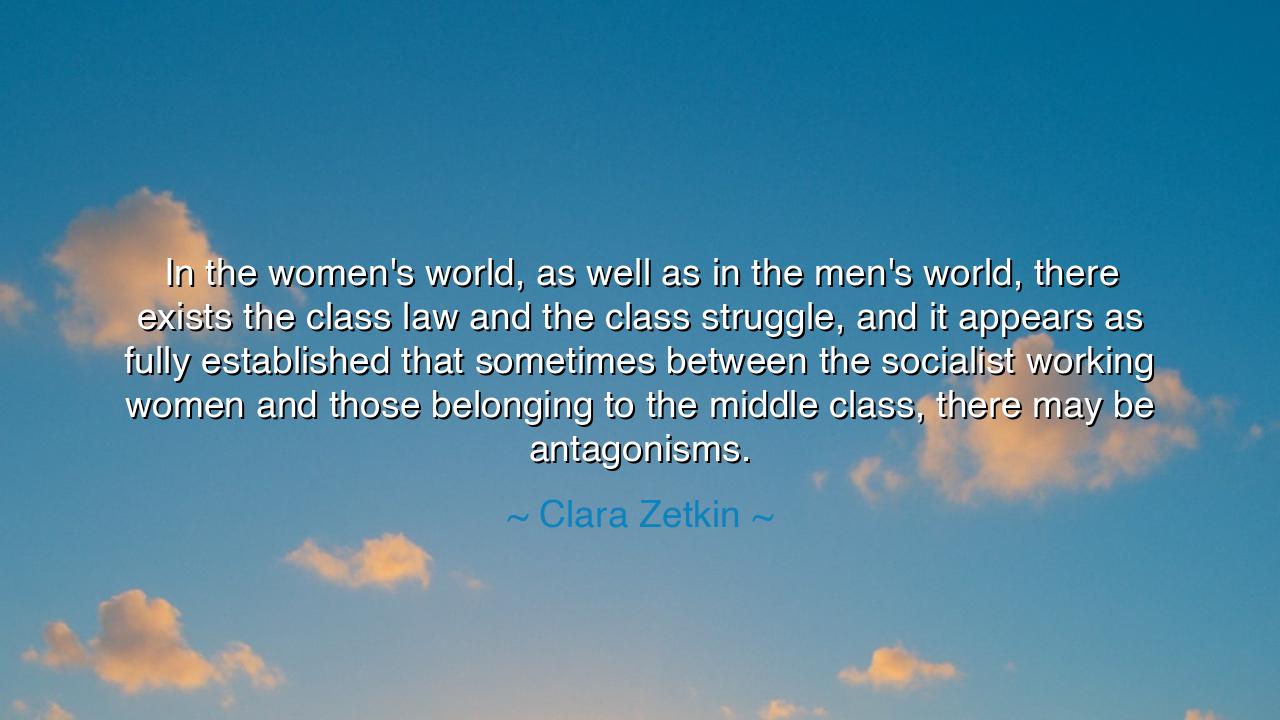
In the women's world, as well as in the men's world, there exists
In the women's world, as well as in the men's world, there exists the class law and the class struggle, and it appears as fully established that sometimes between the socialist working women and those belonging to the middle class, there may be antagonisms.






"In the women's world, as well as in the men's world, there exists the class law and the class struggle, and it appears as fully established that sometimes between the socialist working women and those belonging to the middle class, there may be antagonisms." These words by Clara Zetkin, a pioneering socialist and feminist, shine a light on the complex intersection of gender and class struggles. Zetkin’s statement reveals that while the fight for women’s rights and equality is universal, it is also shaped by the economic structures that define society. Just as the working class struggles against the oppression of the elite, so too do women of different social classes find themselves in opposition at times. In this battle for justice and equality, it is not simply the issue of gender that divides, but the deep economic divisions that create rifts even among those who might otherwise unite under the banner of liberation.
In the ancient world, the struggle for justice was often framed as a battle between different classes and strata of society. The Athenians, for example, were familiar with the tension between the elite and the working classes, between the aristocracy and the common folk. The democratic reforms introduced by Solon were meant to alleviate some of the inequalities between the nobles and the poor, but even within Athenian democracy, there were clear distinctions between those who held power and those who were oppressed. These class struggles were mirrored in many societies, as people sought not only political rights but the economic justice that would allow them to live with dignity.
Zetkin’s insight into the division within the women’s movement reflects a similar dynamic that played out in ancient Rome. The plebeians—the common people—were often at odds with the patricians, the wealthy elite who controlled the political and social structures. The struggles of women in Rome were inextricably linked to the larger issue of class; while some women of the elite class had greater freedoms and influence, women of the lower classes—slaves or laborers—faced far harsher conditions. These class divisions were also apparent in the struggles of the early Christian communities, where the women of the elite found it easier to embrace the new faith, while those of the poor had to grapple with their daily survival while seeking the promise of spiritual liberation.
In the modern context, Zetkin’s words are as relevant as ever. The class struggle within the women’s movement persists, often manifesting in the divide between working-class women and middle-class women. Working-class women, often engaged in manual labor or factory work, face not only gender inequality but also the brutal realities of economic oppression. They are fighting not just for equality but for the basic rights to fair wages, safe working conditions, and dignity in a system that exploits their labor. On the other hand, middle-class women, while also fighting for gender equality, often do so from a position of relative comfort, their struggles framed within the context of professional empowerment and social mobility rather than survival. This divide can create antagonisms, as middle-class women may not fully understand the depth of the economic oppression that working-class women face, leading to tensions within the feminist movement.
The labor movements of the 19th and 20th centuries provide real-life examples of the class antagonisms Zetkin spoke about. Clara Zetkin, herself, was at the forefront of socialist movements, advocating for the rights of working women while confronting the realities of the class divide. The women’s suffrage movement, for example, was often divided along class lines. Middle-class suffragists sought the right to vote from a place of privilege and social standing, whereas working-class women often struggled to secure their basic rights and address economic inequalities that kept them trapped in poverty. The divide between these groups at times undermined the larger feminist agenda, as it became clear that gender equality was bound up with economic justice.
The lesson Zetkin offers us is both powerful and challenging. It reminds us that the fight for justice is not just a matter of gender but is deeply connected to the economic systems that structure society. Women’s liberation cannot be fully achieved unless class divisions are addressed and understood. Economic oppression is often the silent force that keeps the most vulnerable women from rising to equality. To truly liberate women, we must build solidarity across class lines, understanding that a woman’s struggle is not only for equality with men but also for economic freedom from the forces of capitalism and exploitation.
In practical terms, this means that feminist movements must be inclusive, acknowledging the unique struggles faced by women from different economic backgrounds. It also means that those of us with privilege—whether from class, race, or education—must actively listen to and understand the perspectives of women who are less privileged, offering our support and solidarity in ways that address economic disparities. Whether through unionization, advocacy for fair wages, or championing social policies that ensure equality for all, we must work together to bridge the divide between women of different economic classes and fight for a world where all women can stand on equal ground.






AAdministratorAdministrator
Welcome, honored guests. Please leave a comment, we will respond soon